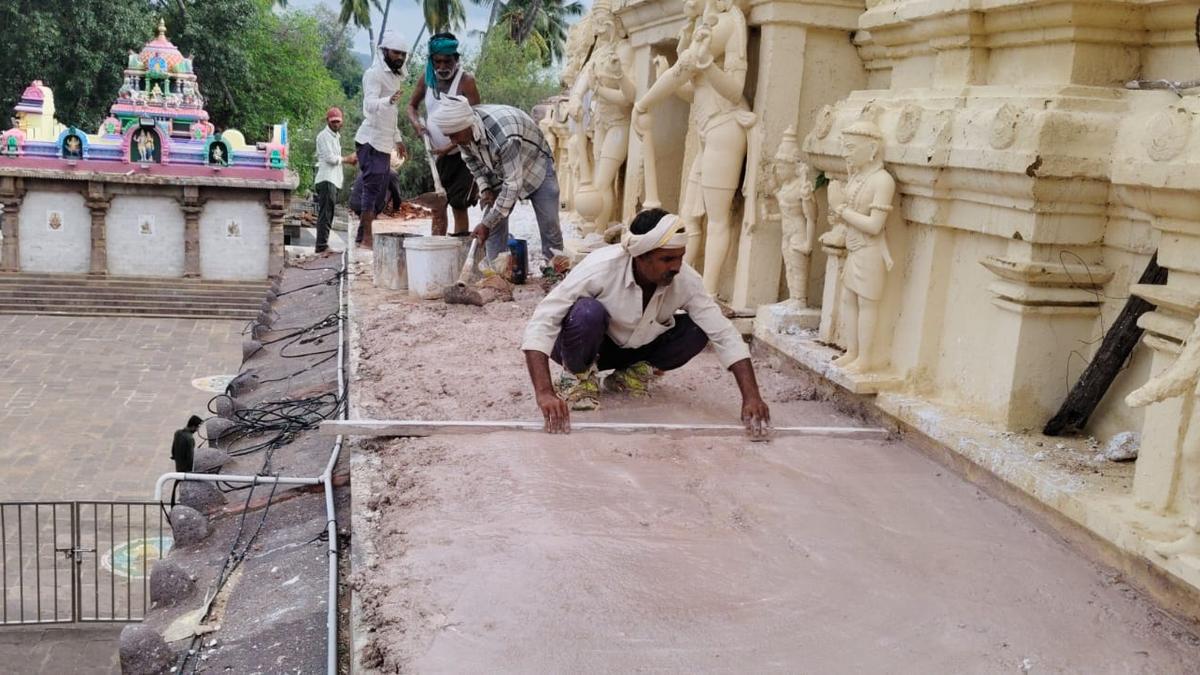Restoration works at the revered Jyotirlinga shrine of Sri Bhramaramba Mallikarjuna Swamy in Srisailam, undertaken by the Archaeological Survey of India (ASI), are progressing swiftly. The works aim to address structural leakages using traditional techniques, alongside the replacement of damaged beams and columns. Spanning approximately 40,000 square feet, the restoration encompasses both the main temple and its sub-temples. The project, estimated to cost ₹7 crore, is being undertaken with the support of Pune-based M/s Lord Venkateswara Charitable and Religious Trust.
The restoration works are being taken up in a manner that there are no deviations from the prevailing architectural style of the temple, said Sri Bhramaramba Mallikarjuna Swamy temple Executive Officer M. Srinivasa Rao. “Material used in construction of age-old temples is being used to address the leakages and the stones that are damaged will be replaced by the same style,” he said.
Talking about the causes, the EO said, “There used to be nearly nine natural springs in the temple premises of which five are visible even today. The drying and decline of these springs had caused soil erosion and damage to some pillars. These damaged pillars will also be replaced as part of the ongoing works.”
K. Munirathnam Reddy, Director (Epigraphy), ASI Mysuru, said that the history of Srisailam temple dates back to the Third Century C.E. (Common Era) as per the inscriptions of Ishvakus of Nagarjuna Konda. “Even in our recent findings of inscriptions dating back to the Third and Fourth century in Lankamalla forests, there was a mention about the Srisailam temple,” he said. The temple construction style, however, is of the sixth or seventh century, he added.
Temple officials and the ASI team involved in the restoration activity admitted that the leakages were not sealed properly even though cement was used for the purpose. “The engineering department officials took repairs using cement but the problem persisted. In fact, it was an overload on the structure,” the officials clarified.
Mr. Munirathnam Reddy said that the team started peeling off the cement that was used to stop the leakages in the structures and added that large tanks were built in the temple premises to mix natural ingredients used for the restoration works.
Concrete for the restoration works is being prepared with natural ingredients using the methods followed by ancient dynasties like Pallavas, Cholas, Pandyas, Badami Chalukyas, Vengi Chalukyas, Kalyani Chalukyas, Kakatiyas, Yadavas and Vijayanagara, Mr. Reddy said, adding, “It is prepared by soaking and mixing Karakkaya (Indian Hog Plum), jaggery, ladies finger extract, lime, jute, urad daal (Vigna mungo) and natural Arabic tree gum.”
The ongoing restoration works encompasses both the main temple of Sri Bhramaramba Mallikarjuna Swamy and its sub-temples in Srisailam.
| Photo Credit:
BY ARRANGEMENT
He said that unlike the temples they had restored earlier, they found some beams and columns were also damaged due which the works might be delayed. “The damaged beams and columns were made of black stone, which is being sourced from Kumbakonam and Bengaluru. Carvings similar to that of the existing structure are being made on these stones,” he said.
He said that the works are likely to be completed in the next six months and these works will ensure that the temple structure remains stable and strong for the next 200 years without any need for further intervention or repairs.
According to officials, an expert team comprising representatives from IIT-Tirupati, Archaeology Department, and an engineering team from Pune inspected the works earlier in May.
Founder of “Mana Ooru Mana Gudi Mana Bhadyatha” (Our village, our temple, our responsibility) M.V. Sivakumar Reddy lauded the ASI for taking up the restoration works in a systematic and scientific manner.
It may be mentioned here that the Archaeological Survey of India had earlier completed the restoration works of the Sri Kalahasteeswara Swamy temple in Srikalahasti, followed by the Sri Varaha Lakshmi Narasimha Swamy temple atop Simhachalam Hill in Visakhapatnam. The roof restoration of the Srikalahasti temple covered 60,000 square feet and was completed in 14 months at a cost of ₹5 crore, while the restoration at Simhachalam spanned approximately 40,000 square feet, with an estimated cost of ₹4 crore.
Published – October 03, 2025 09:52 pm IST
link

